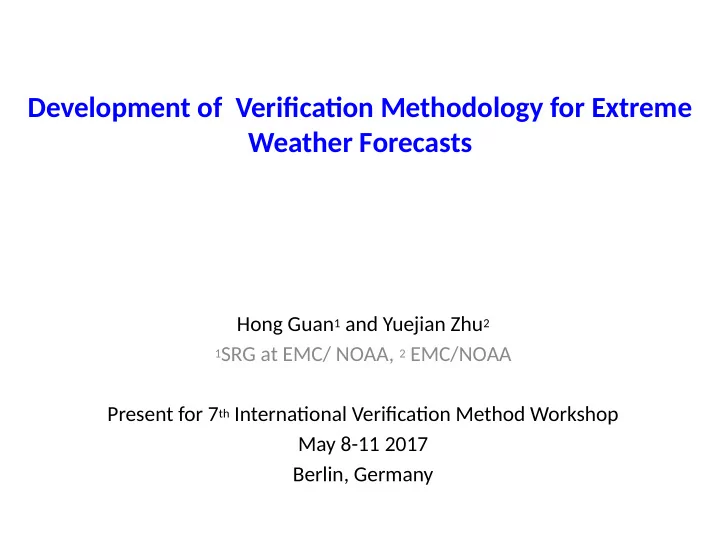

Development of Verifjcatjon Methodology for Extreme Weather Forecasts Hong Guan 1 and Yuejian Zhu 2 1 SRG at EMC/ NOAA, 2 EMC/NOAA Present for 7 th Internatjonal Verifjcatjon Method Workshop May 8-11 2017 Berlin, Germany
Highlights • Defjnitjons of extreme • Common extreme weather forecast products — Anomaly Forecast (ANF) and Extreme Forecast Index (EFI) • Developments of verifjcatjon methodology — ANF and EFI comparison — Verifjcatjon of extreme cold event forecasts — Verifjcatjon of extreme heavy precipitatjon forecasts • Conclusion and future plan • Reference
Defjnitjon of Extreme Events Climatological (forecast) extreme is the tails of corresponding distributjon for a partjcular variable, tjme, and place.
Extreme Weather Forecast Methods – Anomaly Forecast (ANF) EMC/NOAA since 2006 – Extreme Forecast Index (EFI) CMC, ECMWF, and ESRL/NOAA
Anomaly Forecast (ANF) σ 2σ 3σ 50% 68.2% 95.4% 99.6% 50% Schematjcs diagram for anomaly forecast (PDF) Defjnitjons for Anomaly Forecast Defjnitjons for Anomaly Forecast Percentage of ensemble forecast (shaded area) which exceeds climate threshold for Percentage of ensemble forecast (shaded area) which exceeds climate threshold for example: exceeding 2σ of ensemble mean example: exceeding 2σ of ensemble mean or exceeding 3σ of 20% ensemble forecast or exceeding 3σ of 20% ensemble forecast
Anomaly forecast σ 3σ 2σ 8-day fcst 6-day fcst Hurricane Sandy Hurricane Sandy 5-day fcst 4-day fcst
Extreme Forecast Index (EFI) (Lalauretue, 2003) EFI [-1, 1] The EFI is a measure of the difgerence between the model climatological forecast distributjon and the current ensemble forecast distributjon. CDF: cumulatjve distributjon functjon 1 p F ( p ) 2 Modifjed Equatjon f EFI dp ( Zsooter 2006) p ( 1 p ) 0
Parallel GEFS based EFI (ref: 18 years refcst – EMC)
Anomaly Forecast and Extreme Forecast Index Challenges? • How to verify extreme forecast? • How to compare these two measures? • Relatjvely, what EFI value is equivalent to standard deviatjon (e.g. 2σ) anomaly of ensemble mean (as an example)?
Relatjonship between ANF and EFI for 2-m temperature Ensemble Mean Anomaly Forecast (AN) from Model Climatology valid 2015030100 (96-hour forecast) – GEFS V11 5 4 5 th order polynomial fjttjng 3 f(x) = 1,29x^5 - 0,06x^4 - 0,1x^3 + 0,03x^2 + 2,1x - 0,01 R² = 1 f(x) = 2,39x - 0,05 2 R² = 0,99 (standard deviatjon) 1 0 Linear regression fjttjng -1 -2 2σ (AN) ~= 0.78 EFI -3 -4 -5 -1,2 -1 -0,8 -0,6 -0,4 -0,2 0 0,2 0,4 0,6 0,8 1 1,2 Extreme Forecast Index (EFI) from Model Climatology
Relatjonship between ANF and EFI for Precipitatjon Valid 2014010600UTC (96-hour forecast)- GEFS V11 0.95 0.95 (ANF) ~= 0.687 EFI AN F 0.687 EFI
How can we measure the performance? Thresholds for Extreme Cold Events and Heavy Precipitation Variable analysis ANF EFI Extreme cold -2σ -2σ -0.78 event Extreme 0.95 0.95 0.687 Precipitatjon Apply 2*2 contingency table from selected threshold The Hit Rate (HR) False Alarm Rate (FAR) Frequency Bias (FBI) Equivalent Threat Scores (ETS) Performance diagram
Extreme cold event forecasts and verifjcatjon
Experiments for extreme cold event forecasts and verifjcatjons To estimate the relative performance of different methods, model versions, references, and forecasts – Raw GEFS v11 forecast vs. M-climate (18y control-only reforecast) – Bias-corrected GEFS v10 forecast vs. analysis climatology (30-year CFSR) – Bias-corrected GEFS v11 forecast vs. analysis climatology (30-year CFSR) – Bias-corrected GEFS v11 forecast vs. analysis climatology (40-year reanalysis)
Example of extreme cold weather event (Valid: 2015030500) Comparison between the two methods Observed anomaly (analysis) Extreme Forecast Index (EFI) Anomaly Forecast (AN) 0,8 GEFS V11 Raw T2m 0,7 0,6 Against 0,5 AN EFI Model climatology 0,4 0,3 0,2 0,1 0 HR FAR FBI ETS
Statjstjcs for extreme cold weather event (11 cases) for 13-14 winter (Raw and bias-corrected forecast (V11)) Bias-corrected Forecast Raw Forecast
Statjstjcs for extreme cold weather event (11 cases) for 13-14 winter (V10 and V11 bias-corrected forecast) V11 V10
Statjstjcs for extreme cold weather event (11 cases) for 13-14 winter – bias-corrected V11 forecast for 40yrs reanalysis (from 1959) and 30yrs CFSR (from 1979) Reanalysis Reanalysis CFSR CFSR Reanalysis CFSR
Performance Diagram (Roebber, 2009) Exploitjng the geometric relatjonship between four measures of dichotomous forecast performance: probability of detectjon (POD), false alarm ratjo or its opposite, the success ratjo (SR), bias and critjcal success index (CSI; also known as the threat score).
Performance Diagram for Extreme Cold Events Raw vs. bias-corrected v10 vs. v11 Reanalysis vs. forecasts forecasts CFSR
Extreme precipitatjon forecasts and verifjcatjon
Experiment for extreme precipitatjon forecasts and verifjcatjon To estimate the relative performance of ANF and EFI: – Raw GEFS v11 forecast vs. M-climate (18y control-only reforecast)
Example of Extreme Precipitatjon Forecast ANF EFI b. acpr (shaded) and EFI=0.687 (contour) a . acpr (shaded) and ANOMF=0.95 (contour) 96hr forecast ini. 2014010600 96hr forecast ini. 2014010600 The dependence of the extreme precipitatjon on the geographic locatjon
Example of Extreme Precipitation Forecast and Verifjcation CCP ANF EFI A
Summary, Future Plan and Reference o In this study, we have developed the verification methodology for extreme cold event and extreme precipitation forecasts. A highly correlative relationship between the ANF and EFI is found which allows the determination of the equivalent thresholds from both products for extreme event forecast. The equivalent threshold is variable-dependent. • For 2-m temperature, -2-sigma ANF ~ -0.78 EFI • For 24h accumulated precipitation, 95% ANF ~ 0.687 EFI The methodology has been applied to evaluate the relative performance of different methods, model versions, references, and forecasts. o “Performance diagram” is a useful visualization tool for validating extreme event forecasts. o In the future, we will apply the methodology to other variables. o Reference: Guan, H. and Y. Zhu, 2017: "Development of verification methodology for extreme weather forecasts" Weather and Forecasting, Vol. 32, 470-491
Recommend
More recommend